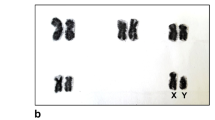Summary
A wide diversity in chromosome complement is found in two species of phasmids of the primitive group Prisopini—Prisopus ariadne Hebard and Prisopus berosus Westwood.
P. ariadne has a diploid male complement of 28, comprising 13 pairs of relatively large mediokinetic autosomes and Neo XY sex chromosomes.
P. berosus, 2n ♂=49, has relatively small autosomes most of which are mediokinetic, and retains the XO—XX sex mechanism. Chromosomal polymorphism in this species is suggested by the presence of an unequal pair of autosomes and a structural differentiation in the X in one of two males studied.
The relative amount of DNA per nucleus in male germ cells (Peulgen cytophotometry) shows a significant difference in total chromosomal content between the complements of the two species.
These data are discussed with reference to the cytotaxonomy of phasmids.
Similar content being viewed by others
References citéd
Ansley, H. R.: A cytological and cytophotometric study of alternative pathways of meiosis in the house centipede (Scutigera forceps Rafinesque). Chromosoma (Berl.) 6, 656–695 (1954).
Bergerard, J.: Etude de la parthénogenèse facultative de Clitumnus extradentatus Br. (Phasmidae). Bull. biol. France et Belg. 92, 7–182 (1958).
Cappe De Baillon, P., et G. de Vichet: La parthénogenèse des espèces Leptynia Pant. Bull. biol. France et Belg. 74, 43–87 (1940).
— M. Favrelle et G. de Vichet: Parthénogenèse et variation chez les phasmes. VI. Discussion des faits — conclusions. Bull. biol. France et Belg. 72, 167–213 (1938).
Favrelle, M.: Recherches sur la spermatogenèse des phasmes. Mâles d'origine bisexuée. Bull. biol. France et Belg. Suppl. 17, 1–155 (1934).
Günther, K.: Über die taxonomische Gliederung und die geographische Verbreitung der Insektenordnung Phasmatodea. Beitr. Entomol. Berlin 3, 541–563 (1953).
Hughes-Schrader, S.: The “premetaphase stretch” and kinetochore orientation in phasmids. Chromosoma (Berl.) 3, 1–21 (1947a).
—: Reversion of XO to XY sex chromosome mechanism in a phasmid. Chromosoma (Berl.) 3, 52–65 (1947b).
Jordan, H. E.: The spermatogenesis of Aplopus mayeri. Carnegie Instn. Washington Publ. 102, 13–36 (1908).
Piza, S. de T.: Primeiras observacoes sobre a citologia de fasmidas Brazileiros. Sci. Genet. 3, 227–235 (1950).
Author information
Authors and Affiliations
Additional information
Supported in part by research grant G-4370 from the National Institutes of Health, Public Health Service.
Rights and permissions
About this article
Cite this article
Hughes-Schrader, S. On the cytotaxonomy of phasmids (Phasmatodea). Chromosoma 10, 268–277 (1959). https://doi.org/10.1007/BF00396574
Received:
Published:
Issue Date:
DOI: https://doi.org/10.1007/BF00396574




